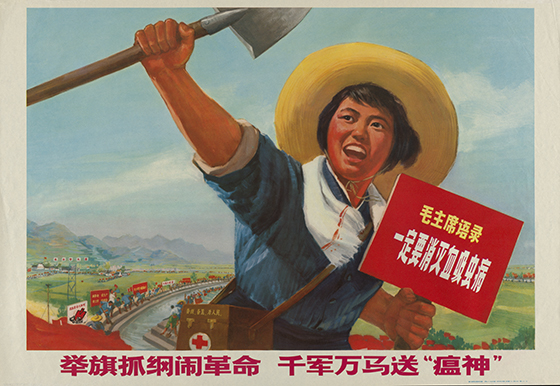“How Societies Choose to Confront Disease:” Tan and Murray on “Strong Bodies for the Revolution” Exhibition


There is a quote attributed to Mao that is still used in daily conversation in China to encourage people to develop better health habits.
“The healthy body is the fundamental investment for the revolutionary cause,’ (or shenti shi geming de benqian),” said Ying Jia Tan, assistant professor of history and East Asian studies.
To illustrate how important this sentiment has been in shaping China’s response to disease, faculty and students have curated an exhibit called “Strong Bodies for the Revolution: Pursuing Health and Power in the People’s Republic of China,” an exhibition featuring a collection of propaganda posters donated by the family of Ruth and Victor Sidel. The exhibit was on display through May 21 in the College of East Asian Studies Gallery at Mansfield Freeman Center
“The exhibition offers a different perspective on the Cultural Revolution and early days of reform and opening,” said Tan. “While the political persecutions carried out during the Cultural Revolution traumatized an entire generation of Chinese people and led to great suffering, many policies were put in place to improve the public health of China’s urban and rural regions.”
During their travels to China, the Sidels acquired more than 55 posters, most of which illustrated the underlying principles that governed Chinese public health policy during tumultuous years of revolution.
The posters donated by the Sidels explore how the Chinese government mobilized its people to implement public health campaigns that improved the health of hundreds of millions of people. There are also common themes in the posters that contribute to a larger narrative about modern health practices in China.
“The exhibition offers us an opportunity to reflect on how societies choose to confront disease,” Tan said.
The centerpiece of the exhibition, a poster about the eradication of schistosomiasis – a parasitic disease carried by water snails that afflicted peasants in rice-growing regions in south China, sums up the challenges faced in the post COVID-19 world, Tan said. The caption on the poster reads ‘Thousand soldiers and ten thousand horses bid farewell to the God of Plague.’
Just as Mao had mobilized the people to eradicate schistosomiasis, China today is pouring massive resources to maintain its zero-tolerance policy on COVID-19. It could take time for Chinese officials to achieve that end. Over five decades of concerted disease controls were enacted before schistosomiasis ceased to be a public health program in 2015.
Tan believes the posters ask intriguing questions. “What can we learn from China’s experience at confronting public health challenges? What are the costs and benefits of public health policies aimed at disease eradication? The posters remind us that one cannot simply wish away the ‘God of Plague,’” Tan said.
He said the posters have generated stimulating discussions during class visits on a whole host of topics, such as state surveillance, gender equality, and social injustices resulting from uneven access to public health facilities.
Wendi Field Murray, Adjunct Assistant Professor of East Asian Studies and Archaeology, and Archaeology Collections Manager, supervised the student preparation of this new donation of posters for the exhibition, giving the public the opportunity to see the images alongside the products of student work, which include translations, cataloging, and research.
Through their collections work, students learned how to ‘read’ three-dimensional objects, to practice good stewardship of cultural objects, and to tease out an object’s capacity to tell stories, Murray explained.
“Object collections are beautifully effective in connecting students to the past, providing a concrete point of departure for exploring abstract concepts (like ‘revolution’ or ‘health’), and helping them to use material culture to critically reflect on the present,” Murray said.
Additional contributors to the exhibition include Kevin and Mark Sidel, sons of Ruth and Victor Sidel, who supported the development of the exhibition and a forthcoming exhibition catalogue.

